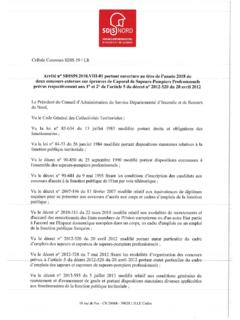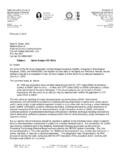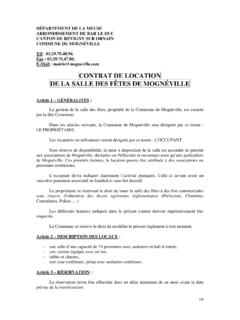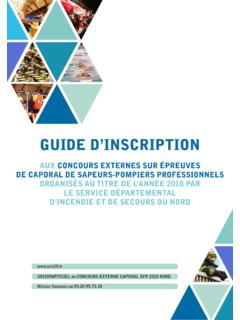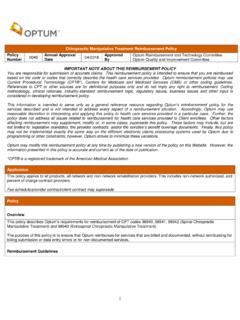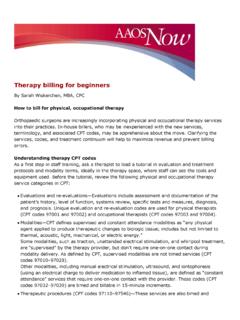Transcription of Using appropriate modifiers for Podiatry to …
1 Using appropriate modifiers for Podiatry to enhance collections Podiatry refers to the branch of medicine which deals with the study, diagnosis and treatment (surgical included) of the ankle, foot and other associated structures of the leg. As in other disciplines, Podiatry too, demands a regular flow of collections for the survival of the practice. In Podiatry , there exists a layer of modifiers for specific procedures along with many rules (insurance) that must be sequenced appropriately. Coding too, for Podiatry is complicated due to a number of procedures carried out on the same organ or its structure leading to a number of codes being used while billing for reimbursements.
2 Hence, to boost collections, minimize errors and avoid dwindling revenues, usage of precise modifiers is an absolute necessity. Medicare generally does not reimburse 'routine foot care.' However, it reimburses under certain circumstances such as: The patient is suffering from a disease affecting circulatory problems or lack of sensation in legs/feet, warts, infections, ulcers, wounds and their treatment, fungal treatment, and the presence of a metabolic, neurologic or peripheral vascular disease. Note: Routine foot care includes the treatment of corns and calluses (cut and removal), nail treatment (cut, clip, and debridement), hygiene care or other services not indicating any infirmity or injury.
3 Here is a list of modifiers used in Podiatry : 1. Q7 - One class A finding - This modifier is to be used in cases of non-traumatic amputation of foot or a part of the integral skeleton. 2. Q8 - Two class B findings - Use this modifier in cases of the absence of posterior tibial pulse or dorsalis pedis pulse, or in cases such as decreasing or absent hair, thickening of nails, pigment change, texture of skin being thin/shiny or skin color becoming red. 3. Q9 - One class B and two class C findings - Use this modifier in case of edema, burning, paresthesia, temperature changes, or claudication. 4. In case of multiple surgeries performed, the coder must mention payable modifiers before the Q range of modifiers , such as TA - T9 which are ten digit toe modifiers or the LT and RT modifiers (left or right).
4 5. HCPCS/CPT codes used in the billing of foot care are: 11055 - Trimming of skin lesion 11056 - Trimming of skin lesion (two to four). Call now 888-357-3226 (Toll Free) 1 Copyright -2016 MBC. All Rights Reserved 11057 - Trimming of skin lesion (more than four). 11719 - Non-dystrophic nails trim 11720 - Debridement of nail (till 5). 11721 - Debridement (more than six). 11730 - Partial or complete nail plate avulsion 11732 - Additional partial or complete nail plate avulsion 6. Coding guidelines for nail debridement - The diagnosis code of the problem along with systemic condition diagnosis code, class find modifiers (as mentioned above), and name and the UPIN of the referring physician along with the apt (last) service date.
5 7. CPT modifier 59: In Podiatry , some services may be performed independently of other services/procedures. In this case, the billers and coders must be aware of Using the CPT Modifier 59. This modifier was altered by Medicare to fit the NCCI (National Correct Coding Initiative) program. These procedures are not described/ documented together as they are not executed upon the patient on the same day by the same physician. The difference is due to the procedure, site, and session or is separately considered due to graze, incision/excision or wound. In the use of another modifier, this modifier (59). must not be used.
6 Again, to remove confusions regarding modifier 59, new HCPCS modifiers were introduced by CMS. It is important to note here that, coders must not use modifier 59 and the below mentioned 'X' modifiers ' attached with the same procedure. XE - Separate Encounter: Refers to a distinct service due to its occurrence separately. XS - Separate Structure: Refers to a distinct service as it has been performed on a different structure/organ. XP - Separate Practitioner: Refers to a distinct service as it has been performed by a different practitioner. XU - Unusual Non-Overlapping Service: Refers to a service which does not overlap with the main service or its elements.
7 8. Other CPT codes: A podiatrist can also bill Using CPT codes 97112 and 97032, but along with the GP. modifier and documentation recorded aptly. This should also be accompanied with a 'plan of care'. synopsis in the record. Apt modifiers aid in clear, timely and accurate billing for claims, reducing denials and increasing collections. As Podiatry uses a number of codes and modifiers , it is imperative that the coders are masters in Podiatry coding. Call now 888-357-3226 (Toll Free) 2 Copyright -2016 MBC. All Rights Reserv


